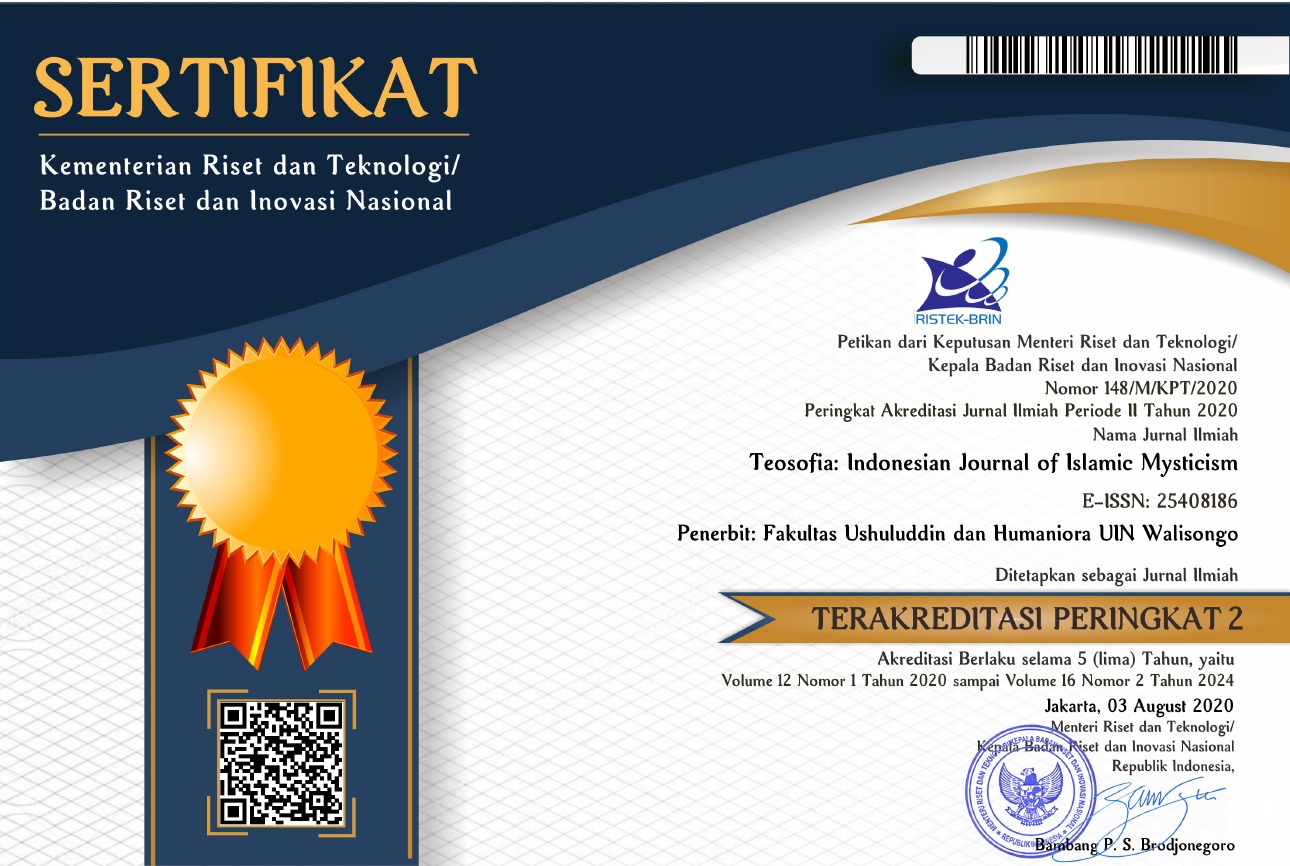THE ETHICAL AND AESTHETICAL DIMENSION OF FIGURATIVE CLASSICAL CALLIGRAPHY PAINTING
DOI:
https://doi.org/10.21580/tos.v5i2.1723Keywords:
Calligraphy Painting, Aesthetic, Isamic ArtAbstract
The current phenomenon indicates that the use of the term of art experienced a shift in meaning, which is arbitrary. Art is only seen as an expression of free expression, without care about the meaning contained in the work of art. However, it is not evident among Moslem artists in expressing their work in figurative calligraphy painting. Although in Islam, painting especially in paint the creature living (figure) got a bad response, but the Moslem artists were able to present works that are not only beautiful but also the messages. The research questions in this thesis are first what is the ethical and aesthetical message of figurative calligraphy painting? And is there a relationship between ethical and aesthetical messages in figurative calligraphy painting? Trough an interpretative qualitative and a symbolic interaction approach. The research concluded that the ethical messages are Posts contain praying illustrated in the form of ‘abid in praying. It contains the meaning that human is weak creature and always does wrong. Therefore, humans need forgiveness from Allah. Posts of Ali Ibn Abi Thalib was illustrated in the form of lion. It describes and contains the meaning of braveness and heroism of Ali in defense of Allah religion. The aesthetical message in every figurative calligraphy painting is a manifestation of the beauty that exists in the universe. Figurative calligraphy painting is described the Majesty, Power and Oneness of Allah, the art was created is the manifestation of tawḥidDownloads
References
Abineno, J. L. C. H., Sekitar Etika dan Soal-soal Praktis, Jakarta: BPK Gunung Mulia, 1994.
Affandi, M., Ekspresi Simbolik, Religius dan Estetika dalam Karya Lukis Kaligrafi, Yogyakarta: FPBS-IKIP, 1994.
Amin, Ahmad, Etika, Jakarta: Bulan Bintang, 1975.
AR., D. Sirojuddin, Seni Kaligrafi Islam, Jakarta: Pustaka Panjimas, 1985.
Al-Baba, Kamil, Dinamika Kaligrafi Islam, trans., Drs. D. Sirojuddin AR., Jakarta: Darul Ulum Press, 1992.
Beg, M. Abdul Jabbar, Seni di dalam Peradaban Islam, Bandung: Pustaka, 1988.
Bekker, Anton dan Ahmad Kharis Zubair, Metode Penelitian Filsafat, Yogyakarta: Kanisius, 1990.
______, Esai Tentang Masalah Aktual Perspektif Etika, Yogjakarta: Kanisius, 2001.
Bertens, K, Etika, Jakarta: Gramedia Pustaka Utama, 1993.
Borchert, Donald M., Philosophy and Ethic, Macmillan Library, 1996.
Bungin, Burhan, Penelitian Kualitatif; Komunikasi, Ekonomi, Kebijakan Publik, dan Ilmu Sosial, Jakarta: Kencana Perdana Media Group, 2010.
Al-Faruqi Isma’il Raji, Tawhid: It’s Implication for Thought and Life, trans. Rahmani Astuti, Bandung: Pustaka, 1982.
______, Seni Tauhid Esensi Dan Ekspresi Estetika Islam, trans. Hartono Hadikusumo, Yogyakarta: Yayasan Benteng Budaya, , 1999.
______, Tauhid; It‟s Implication for Thought and Life, trans. Rahmani Astuti, Bandung: Pustaka, 1982.
Gazalba, Sidi, Asas Kebudayaan Islam; Pembahasan Ilmu Dan Filsafat Tentang Ijtihad, Fiqih, Akhlak, Bidang-Bidang Kebudayaan, Masyarakat, Negara, Jakarta: Bulan Bintang, 1978.
Gjafri, Taufik, Menikmati Keindahan Allah Melalui Logika Dan Tanda-tanda, Malang: Bayumedia, 2004.
Israr, C., Dari Teks Klasik Sampai ke Kaligrafi Arab, Jakarta:Yayasan Masagung, 1985
Khan, Maulana Wahiduddin, Islam the Voice of Human Nature, New Delhi: Goodword Books, 2000.
L., W. Does Poprodjo, Filsafat Moral kesusilaan dalam teori dan Praktek, Bandung: Remadja Karya CV, 1986.
Leaman, Oliver, Menafsirkan Seni Dan Keindahan; Estetika Islam, terj, Irfan Abubakar, Bandung: Mizan, 2005.
Makin, Nurul, Kapita Selekta Kaligrafi Islami, Jakarta: Pustaka Panjimas, 1995.
Muhaya, Abdul, Spiritualitas Bangunan (Studi Tentang Makna Spiritual Arsitektur Pondok Pesantren Salafiyah Bahru Bihari, Asali Fadhaailir Rahmah), Semarang: LP2M IAIN Walisongo Semarang, 2013.
Nasr, Seyyed Hosein, Spiritualitas Dan Seni Islam, terj, Drs. Sutejo, Bandung: IKAPI, 1993.
Nata, Abudin, Akhlaq Tasawuf, Jakarta: Raja Grafindo Persada, 2000.
Pickthall, Muhammad Marmaduke, The Cultural Side of Islam (Islamic Culture), New Dehli: Kitab Bhavan, 1981.
R., Ilham Khoiri, Al-Quran dan Kaligrafi Arab Peran Kitab Suci dalam Transformasi Budaya, Jakarta: LOGOS, 1999.
Salad, Hamdy, Agama Seni Refleksi Teologis dalam Ruang Estetik, Yogyakarta: Yayasan Semesta, 2000.
Scot, John, Teori Sosial Masalah-Masalah Pokok Dalam Sosiologi, terj, Ahmad Lintang Lazuardi, Yogyakarta: Pustaka Pelajar, 2012.
Soedarso, Seni Lukis Kaligrafi Islam, Yogyakarta: ISI , 1992.
Suseno, Franz Magnis, Etika Dasar Masalah-masalah Pokok Filsafat Moral, Yogjakarta: Kanisius, 1997.
Yudoseputro, Wiyoso, Pengantar Seni Rupa Islam di Indonesia, Bandung: Angkasa, t.th.
Yuliman, Sanento, Dua Seni Rupa, Jakarta: Kalam, 2001.
Yustiono, dkk, Islam dan Kebudayaan Indonesia Dulu, Kini dan Esok, Yayasan Jakarta: Festival Istiqlal, 1993.
Bambang Sunarto, 2010, Etika dan Pertimbangan I Wayan Sadra dalam Penciptaan Karya Seni.
http://bsunarto.blogspot.com/2010/09/etika-danpertimbangan-i-wayan-sadra.html?m=1, accessed 23 march 2015
Downloads
Published
How to Cite
Issue
Section
License
Copyright
The copyright of the received article shall be assigned to the journal as the publisher of the journal. The intended copyright includes the right to publish the article in various forms (including reprints). The journal maintains the publishing rights to the published articles. Therefore, the author must submit a statement of the Copyright Transfer Agreement.*)
Licensing

This work is licensed under a Creative Commons Attribution-ShareAlike 4.0 International License.
In line with the license, authors are allowed to share and adapt the material. In addition, the material must be given appropriate credit, provided with a link to the license, and indicated if changes were made. If authors remix, transform or build upon the material, authors must distribute their contributions under the same license as the original.
_______
*) Authors whose articles are accepted for publication will receive confirmation via email and send a Copyright Transfer Agreement.









